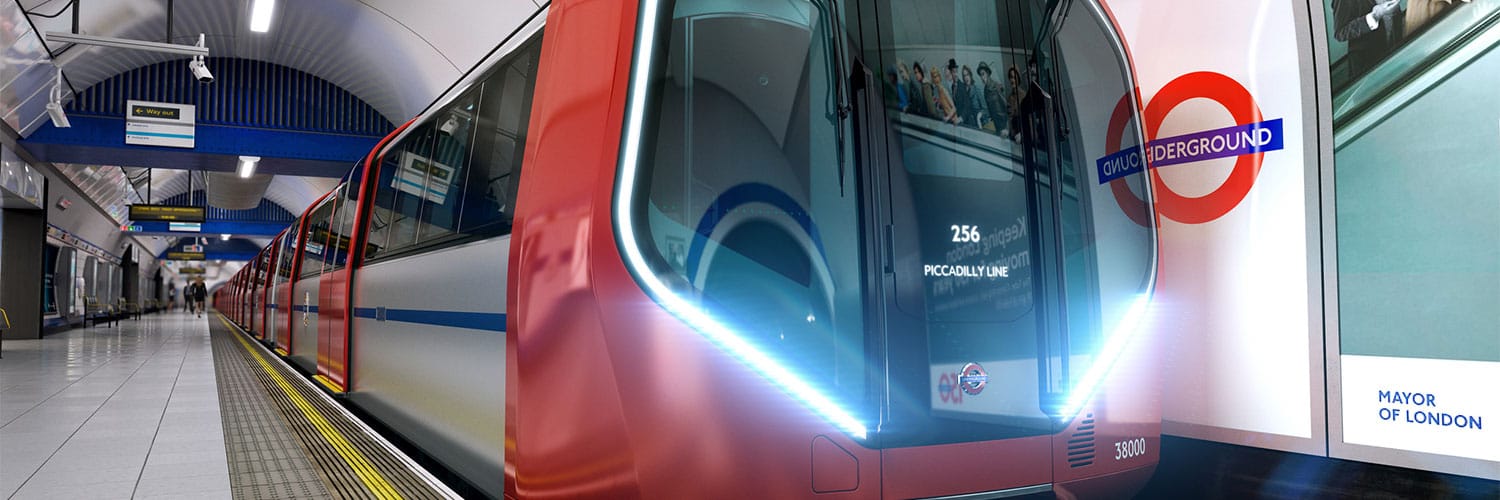
The public transportation system in London is immense, consisting of buses, trains, on-street trams, boats and even a cable car. Managed by Transport for London (TfL), the majority of the network is wheelchair accessible, though there are still some limitations to access on the underground metro and overground train systems. A renewed focus on accessibility has brought positive improvements, opening more of London to both residents and tourists with disabilities.
For wheelchair users visiting London, public transportation is an invaluable resource, saving you time and money when exploring the city. For the best experience on public transit, take advantage of the full network and explore each mode of transport offered by TfL. With this guide to wheelchair accessible public transportation in London, you’ll be prepared to take on the sights and sounds of England like a pro.
Accessible Journey Planner
If you’re looking to take an accessible journey using London’s public transportation system, I strongly recommend TfL’s online journey planner tool. Unless you will travel exclusively on the city bus, the journey planner tool will account for your wheelchair accessibility needs in a way that Google Maps cannot.
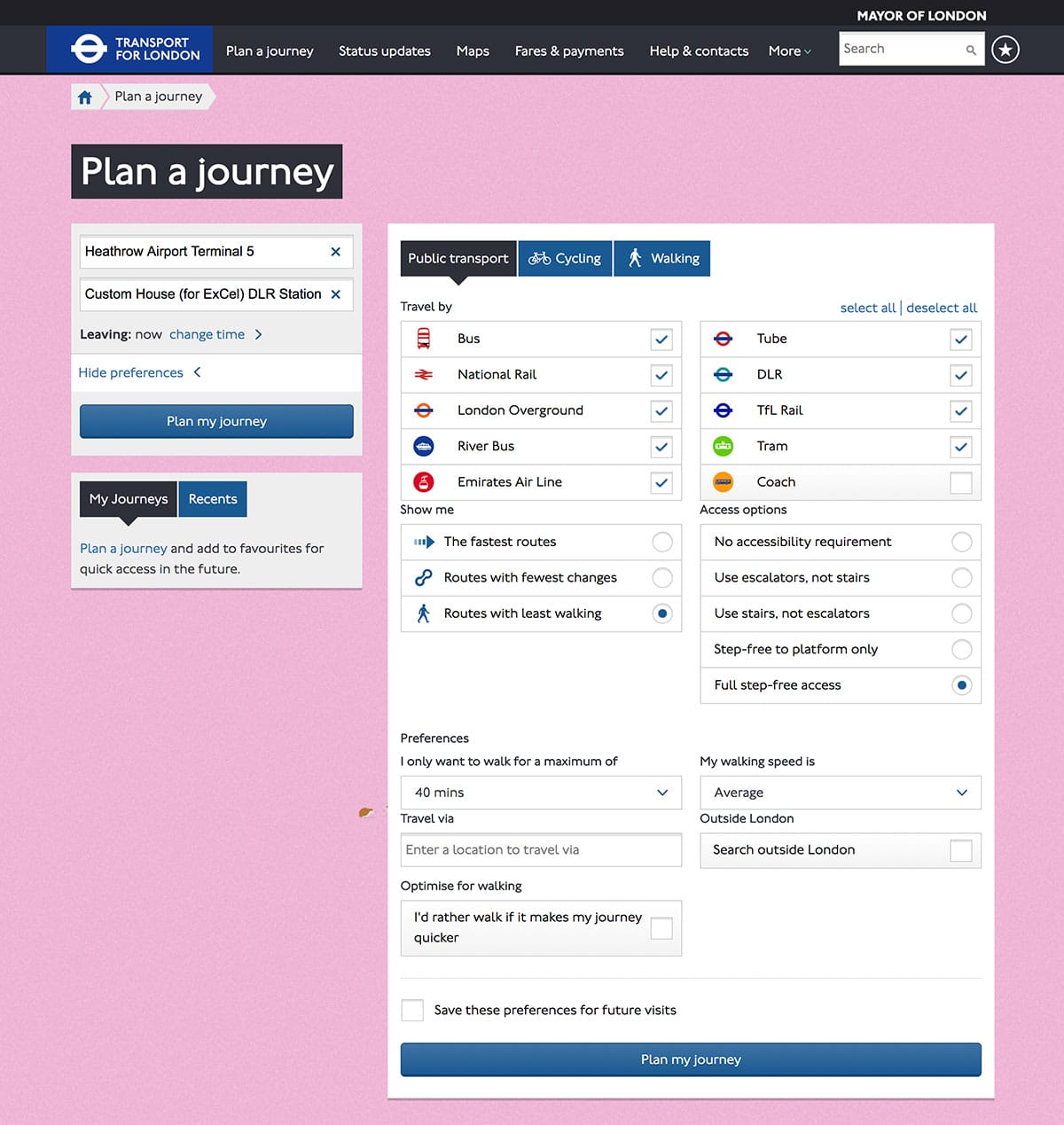
In the screenshot above, I entered Heathrow Terminal 5 as my departure point and the London ExCel Center as my destination. I set the parameters in the search tool to reflect my accessibility needs, including ticking the box for “full step-free access,” which is important for wheelchair users.
The journey planner will load the best possible routes matching the settings you selected, and it will even advise of potential delays due to maintenance, malfunctioning trains, station closures or traffic. It is an excellent resource for travelers in London, especially for wheelchair users and others with reduced mobility.
London City Bus
London’s city bus system is one of the world’s best for people with disabilities, with a fleet of more than 9,000 buses being wheelchair accessible. The network consists of approximately 700 routes serving more than 17,000 stops.
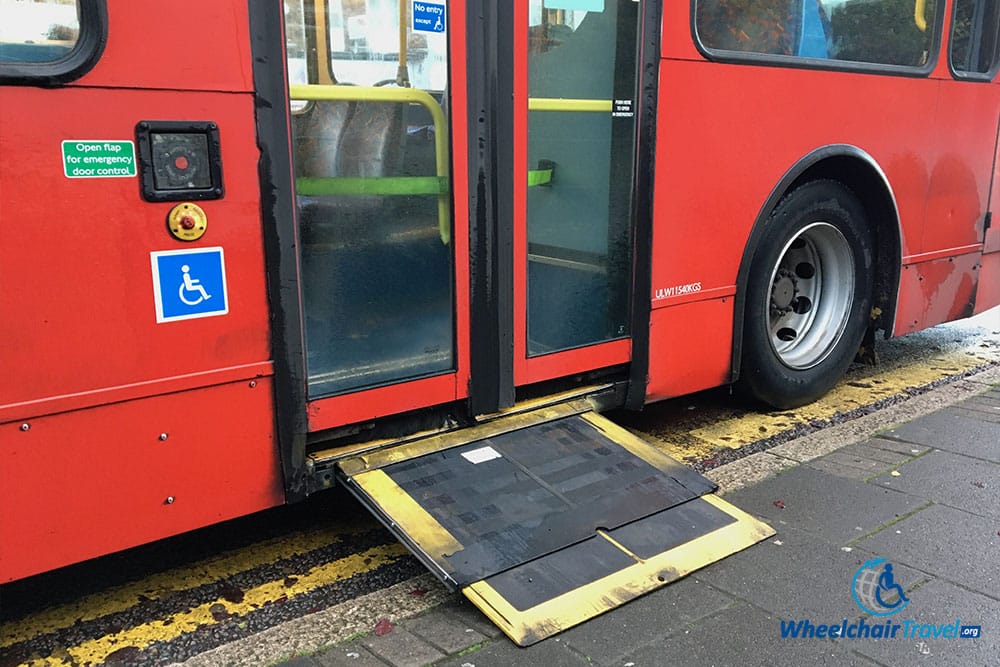
Each city bus has an electronic wheelchair ramp that extends from the rear door. A button with a wheelchair icon located next to the door on the outside of the bus allows you to notify the driver that you need the ramp. Back away as the ramp is extended, and proceed up the ramp. A wheelchair parking space will be directly ahead, and it is best to back your wheelchair into this space. A button positioned on the grab bars nearby will allow you to alert the driver of your stop. In most cases, that alert comes in the form of a brief alarm sound.
Bus drivers will not leave their seat to assist you, and there are no wheelchair securement straps available on London’s city buses. That said, I have never had any difficulty in making use of the London bus system, even with a large power wheelchair. The system just works, and most bus routes run every 10 to 15 minutes.
Wheelchair users are not expected to pay to ride the city buses in London, so you’ll save money by using them when visiting the city. For a list of London city bus routes, visit the TfL website at www.tfl.gov.uk.
London Underground (Tube)
The London Underground is a metro subway system consisting of 11 lines, 270 stations and more than 250 miles of track. The system began operation in 1863, but accessibility did not become a priority until the extension of the Jubilee Line in 1999. In fact, prior to 1993, wheelchairs were prohibited from utilizing the Underground on account of fire regulations.
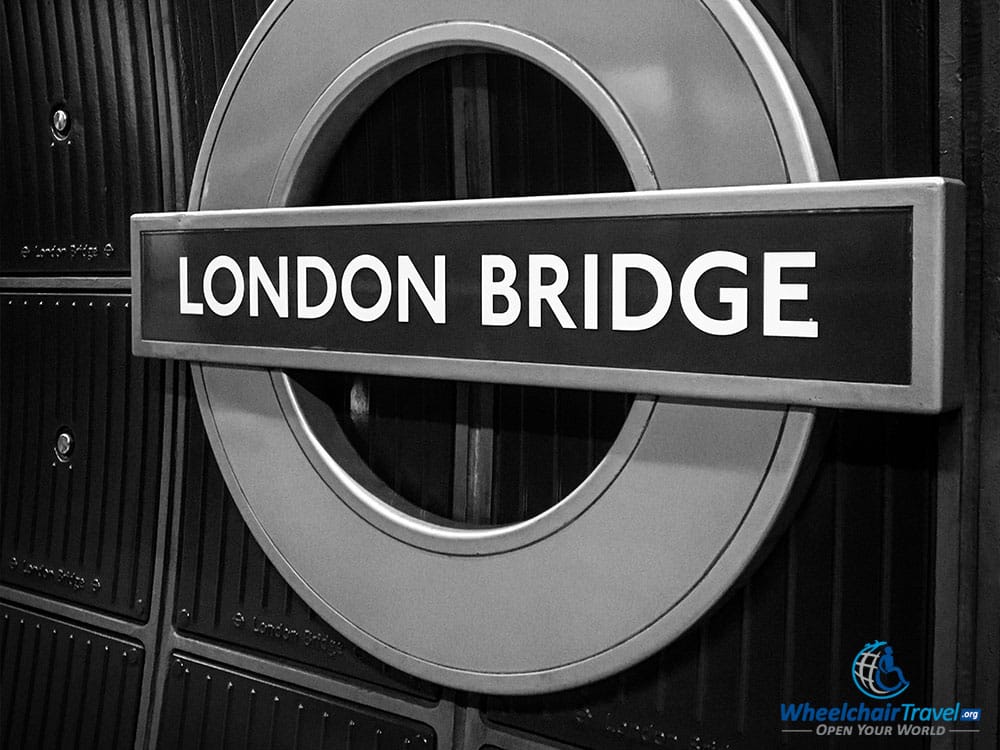
Understanding the accessibility of London Underground stations can be challenging, but Transport for London provides a PDF guide to step-free access on the tube. Since that guide can be difficult to understand, I strongly recommend that you plan your tube journeys using the TfL Journey Planner.
Accessibility of London Underground Trains
Although brand-new and highly accessible trains are being added to the fleet at regular intervals, many of the older carriages date to a time when wheelchair accessibility was not a priority.
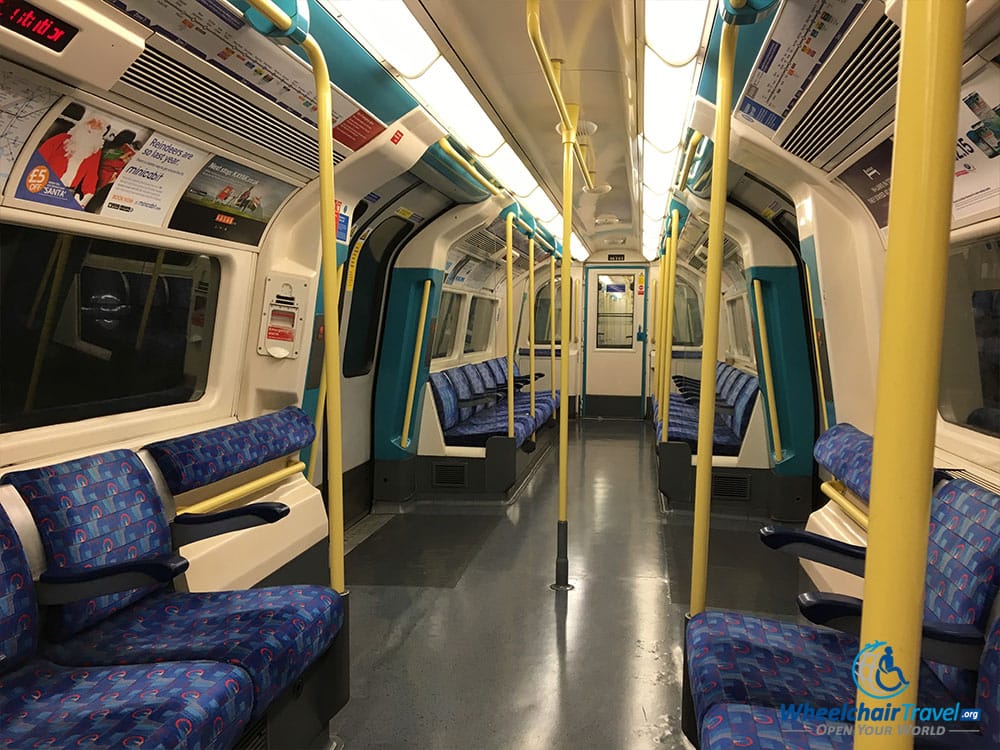
Newer trains feature large spaces for wheelchairs, while some of the older carriages offer smaller spaces that were designed only with manual wheelchairs in mind. On many lines, it is the “luck of the draw” as to what type of train you will encounter. Fortunately, even as the user of a large power wheelchair, I haven’t had problems fitting onto any of the different train styles. Do keep in mind that the trains are often packed with people (to capacity) during the typical rush hours, and you may experience delays as a result.
List of London Underground stations with step-free access from platform to train
The following London Underground stations (grouped by line) are accessible to the vast majority of wheelchair users, with the gap between the platform and train being no greater than 3.3 inches (usually less) and the vertical distance (the step up or down) between the platform and train being no greater than 2 inches.
- Circle — Hammersmith, King’s Cross
- District — Barking
- Hammersmith & City — Barking, Hammersmith, King’s Cross
- Jubilee — Bermondsey, Bond Street, Canada Water, Canary Wharf, Canning Town, Green Park, Kingsbury, London Bridge, North Greenwich, Southwark, Stratford, West Ham, Westminster
- Metropolitan — Chalfont & Latimer, Chorleywood, King’s Cross, Pinner, Wembley Park
- Northern — Edgware, Finchley Central, Herndon Central, High Barnet, King’s Cross, London Bridge, Morden, Tottenham Court Road, Woodside Park
- Piccadilly — Earl’s Court, Green Park, Heathrow Terminals 2 & 3, Heathrow Terminal 4, Hounslow West, King’s Cross, Oakwood
- Victoria — Brixton, Green Park, King’s Cross, Tottenham Hale
In some stations, only a portion of the platform may be raised to allow level boarding of trains. Pay attention to signage to ensure you are boarding the appropriate car for the station you plan to alight at, as the raised platforms are not always in the same locations. Ask a staff member for assistance if you are unsure.
The following underground stations (grouped by line) are step-free from the street to the platform, and will require the use of a manual boarding ramp to get a wheelchair on or off the train. Reach out to station personnel at the start of your journey to request the boarding ramp wherever necessary – whether at the departure, transfer or terminus points of your trip.
- Bakerloo — Harrow & Wealdstone, Wembley Central
- Central — Epping, Hainault, Roding Valley, Stratford, Tottenham Court Road, Woodford
- Circle — Blackfriars, Farringdon, Westminster, Woodford
- District — Acton Town, Blackfriars, Earl’s Court, East Ham, Elm Park, Fulham Broadway, Hammersmith, Kew Gardens, Richmond, Southfields, Upney, West Ham, Westminster, Wimbledon
- Hammersmith & City — Barking, East Ham, Farringdon, West Ham, Wood Lane
- Jubilee — Kilburn, Stanmore, Wembley Park
- Metropolitan — Chesham, Farringdon, Hillingdon, Uxbridge
- Northern — Golders Green, West Finchley
- Piccadilly — Acton Town, Caledonian Road, Hammersmith, Heathrow Terminal 5, Hillingdon, Hounslow East, Sudbury Town, Uxbridge
While I hope these lists of accessible tube stations will help you in planning your accessible journey on London public transit, I must once again encourage you to use the online journey planner tool referenced earlier in this article, as it will surely save you a lot of time and frustration.
London Underground Fares and Payment
Fares on the London Underground are based on the number of zones you will travel through, as well as the time of day. Since there are 9 zones in addition to peak and off-peak travel times to consider, fare calculation on London public transport is more complicated than most. You can use TfL’s online fare calculator to check the cost of a trip between any two points.
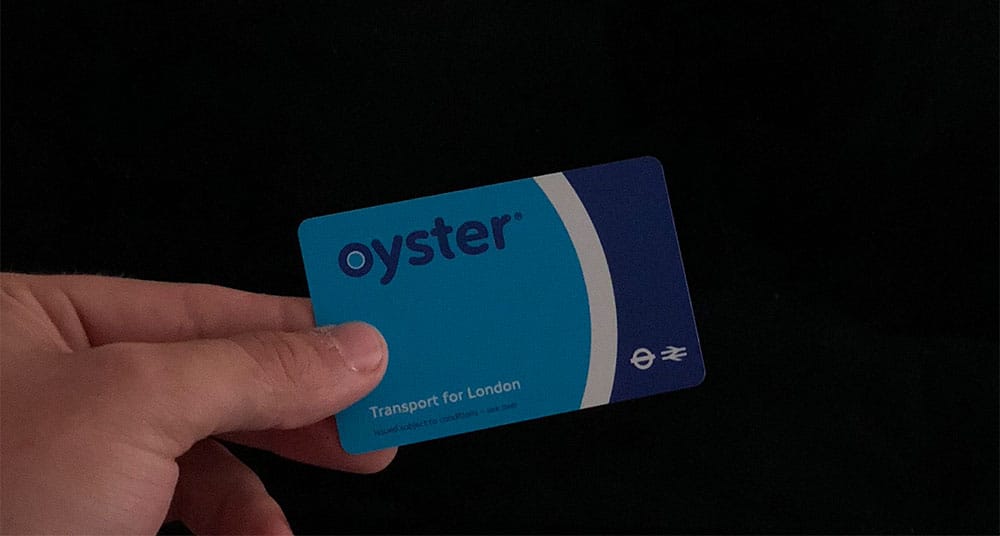
The easiest way to pay for travel on the London Underground is with the reloadable Oyster tap card. You can purchase a card for £5.00 at many stations, visitor centers, and at the airports. The Visitor Oyster Card can be purchased online in advance of your trip, and also costs £5.00. Beyond the convenience of the card’s ease of use, it allows travelers to benefit from a daily cap on fares, depending on the zones they have traveled through. To learn more about fares, visit www.tfl.gov.uk.
Note that your Oyster card can also be used on the DLR, London Overground, TfL Rail and most National Rail services. It works on city buses as well, but wheelchair users are not expected to pay a fare on the London city bus.
London Overground Train
The London Overground is a suburban rail system which began operation in 2007. The network consists of 112 stations spread across 9 routes and has an annual ridership of nearly 200 million. The majority of the system is located outside of Central London, making it primarily a service for commuters.
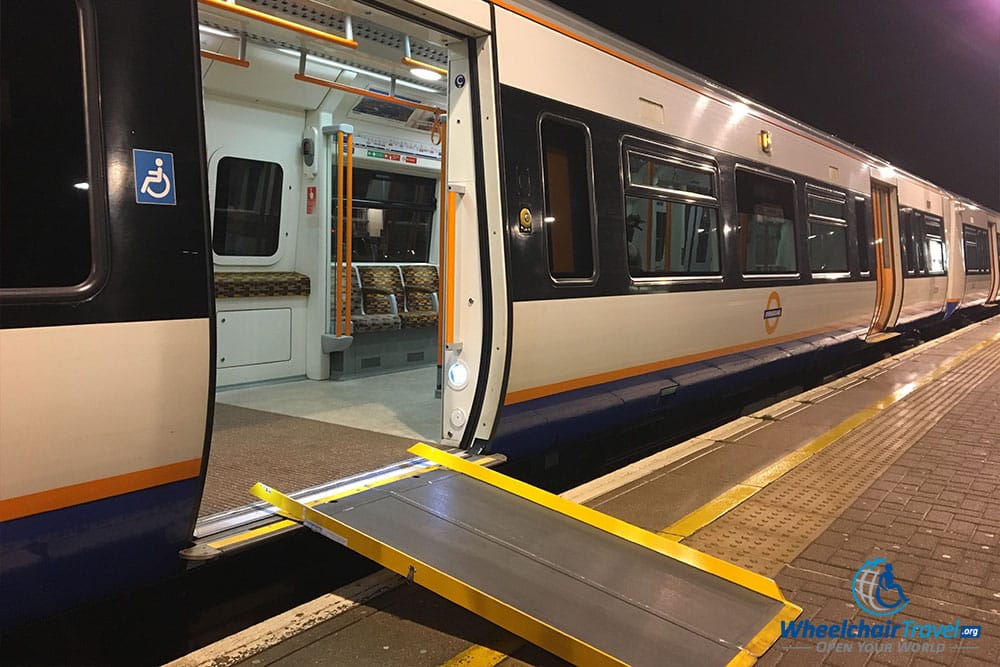
Despite the Overground being barely more than a decade old, less than half of its stations are wheelchair accessible. The following overground stations (grouped by line) are step-free from the street to the platform. A manual boarding ramp is available to wheelchair users and others who have difficulty using steps at each of the stations listed below.
- North London Line — Acton Central, Caledonian Road & Barnsbury, Camden Road, Canonbury, Gospel Oak, Hackney Central, Hackney Wick, Hampstead Heath, Highbury & Islington, Homerton, Kensal Rise, Kew Gardens, Richmond, South Acton, Stratford, Willesden Junction
- West London Line — Clapham Junction, Imperial Wharf, Kensington (Olympia), Shepherd’s Bush, West Brompton, Willesden Junction
- East London Line — Anerley, Brockley, Canada Water, Canonbury, Crystal Palace, Dalston Junction, Forest Hill, Haggerston, Highbury & Islington, Honor Oak Park, Hoxton, New Cross, New Cross Gate, Norwood Junction*, Penge West*, Shoreditch High Street, Sydenham, West Croydon
- South London Line — Clapham Junction, Denmark Hill, Queens Road Peckham
- Watford DC Line — Carpenders Park, Harrow & Wealdstone, Hatch End*, Headstone Lane*, London Euston, Watford Junction, Wembley Central, Willesden Junction
- Gospel Oak to Barking Line — Barking, Gospel Oak, Harringay Green Lanes, South Tottenham, Upper Holloway, Walthamstow Queen’s Road
- Lea Valley Lines — Bush Hill Park, Cheshunt, Chingford, Edmonton Green, Enfield Town, Highams Park, London Liverpool Street, Walthamstow Central
- Romford to Upminster Line — Emerson Park, Romford
For stations marked with an asterisk, please consult the TfL accessibility map for more information on accessibility that may impact your ability to use the station.
Fares on the London Overground can be paid with the Oyster card. For more information, or to determine the cost of a specific trip, visit www.tfl.gov.uk.
London DLR Trains
The Docklands Light Railway, or DLR, is a fully accessible light rail system that is easy to use and provides step-free access from the street onto the trains at all 45 stations. The system consists of 7 lines and the rail carriages are modernized.
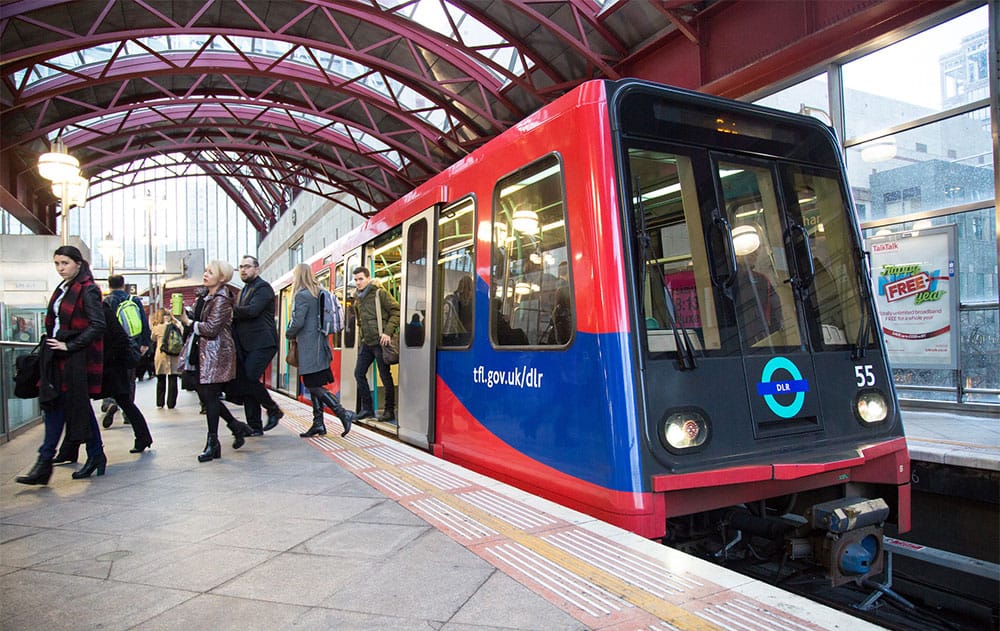
Accessible connections to the London Underground, Overground, National Rail, Emirates Air Line and city bus services are possible at various stations. A map of the DLR service area and connections to other modes of transit is available here (PDF) Fares can be paid using the Oyster Card.
London River Boats
The London River Bus is a wheelchair accessible boat service that runs up and down the River Thames in Central London. Riding a boat is always a fun experience, but the River Bus creates access in an area where the London Underground stations fall short. Check out this video created by TfL that shows how easy the experience can be for wheelchair users.
The service is operated by Thames Clippers, and all of the boats are wheelchair accessible. Due to their larger size, not all mobility scooters can be accommodated on the boats and must be approved in advance of travel. If you plan to visit London with a scooter, please read up on the requirements of the Mobility Scooter Recognition Scheme at www.thamesclippers.com.
Tickets can be purchased at the pier with cash, or with a tap of your Oyster Card. Cash rates run from £4.40 to £9.90 each way, depending on the number of zones you will travel through. When paying with an Oyster Card, you will receive a discounted fare of £3.90 to £7.50 each way.
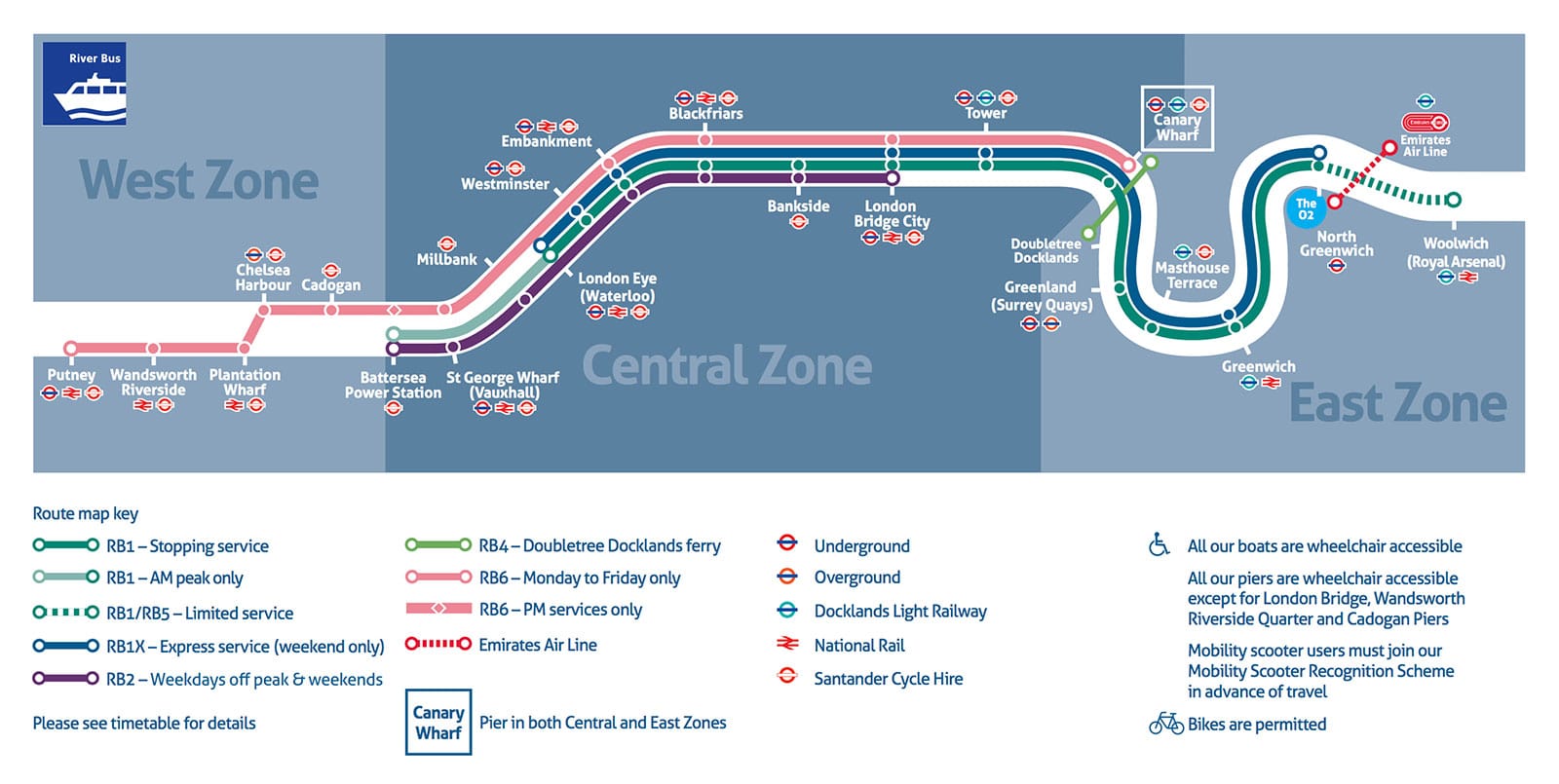
All of the River Bus piers are wheelchair accessible, with the exception of Cadogan Piers, London Bridge and Wandsworth Riverside Quarter.
Emirates Air Line Cable Car
Cable cars can play a role in public transportation too! The Emirates Air Line Cable Car (full review here) is wheelchair accessible and connects Greenwich Peninsula with the Royal Docks.
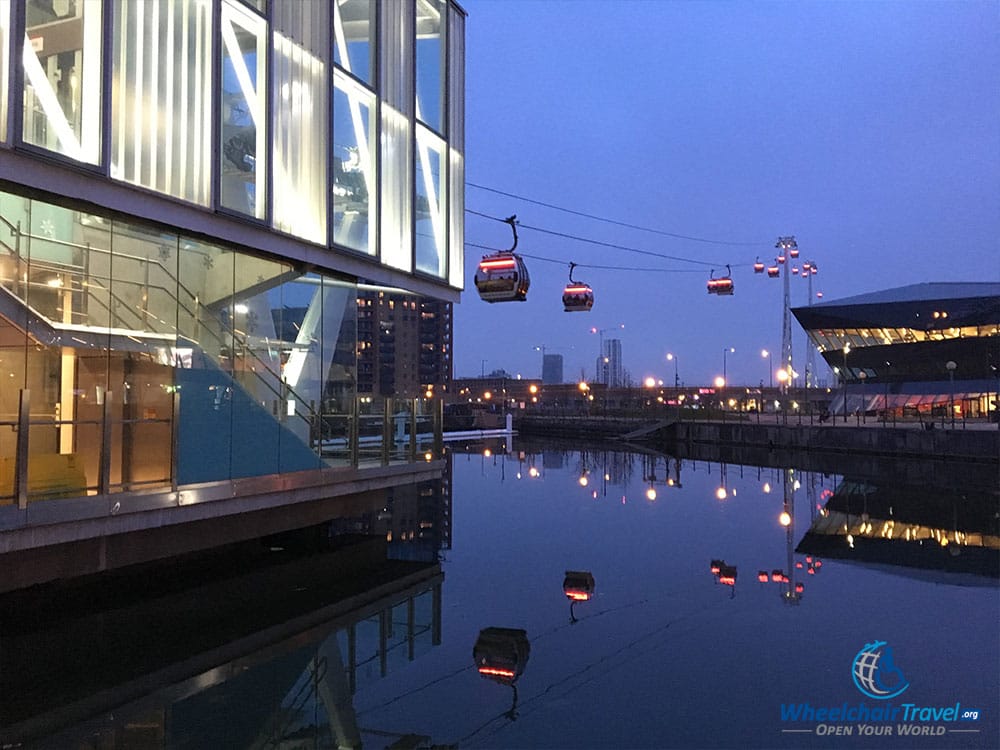
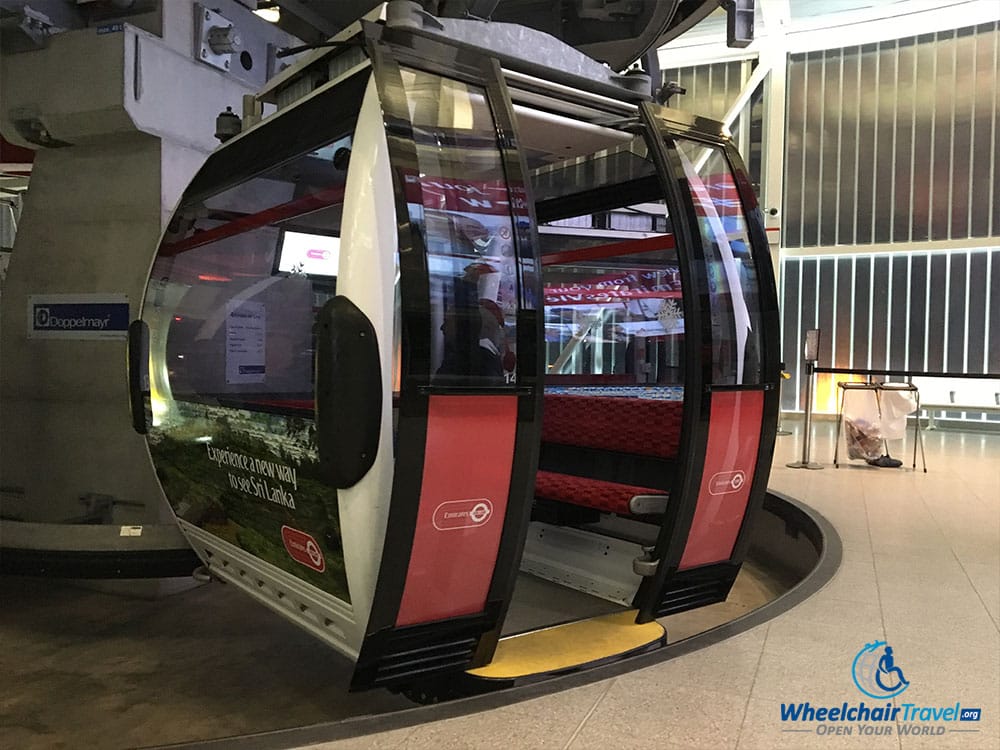
The cable car station on Greenwich Peninsula is within walking distance of The O2 Arena and the Jubilee Line at the wheelchair accessible North Greenwich underground station. The station at the Royal Docks makes a connection to the wheelchair accessible DLR train possible, at Royal Victoria station. The London ExCel conference and events center is just one DLR stop away.
For more information and to learn about fares, visit www.tfl.gov.uk.
National Rail (Northern & Southern lines)
Many National Rail lines operate in and around London, but I have only made use of the Northern and Southern lines myself. For the best experience, it is highly recommended that you book wheelchair assistance at least 24 hours in advance of your trip. While I have been accommodated on short notice, several British readers have told me that is not always possible.
For a list of who to contact for disability assistance at the national rail operating companies, visit www.nationalrail.co.uk.
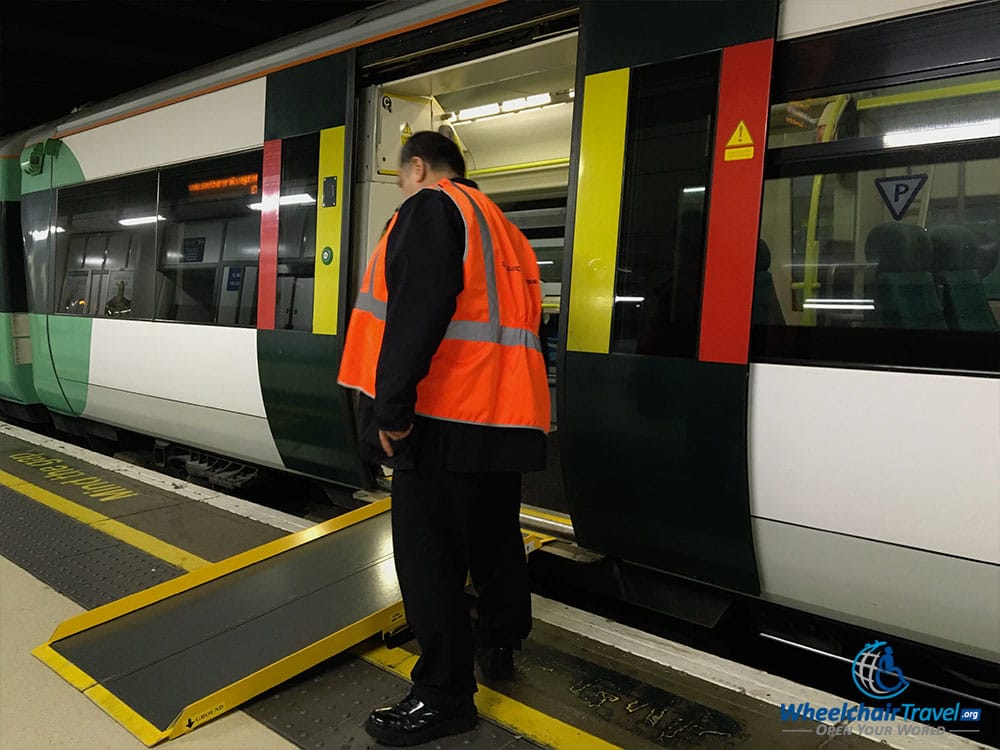
The photo above depicts a wheelchair accessible boarding ramp laid out to assist me in boarding a Southern line train. I was taking this particular train from London Victoria Station to London Gatwick Airport.
Most National Rail trains have dedicated spaces for wheelchairs as well as accessible bathrooms onboard.
Because my experience riding National Rail is limited, I recommend visiting www.transportforall.org.uk for additional resources and information.
Heathrow Express Train
The wheelchair accessible Heathrow Express train offers high-speed, non-stop rail service from London Heathrow Airport to London Paddington Station.
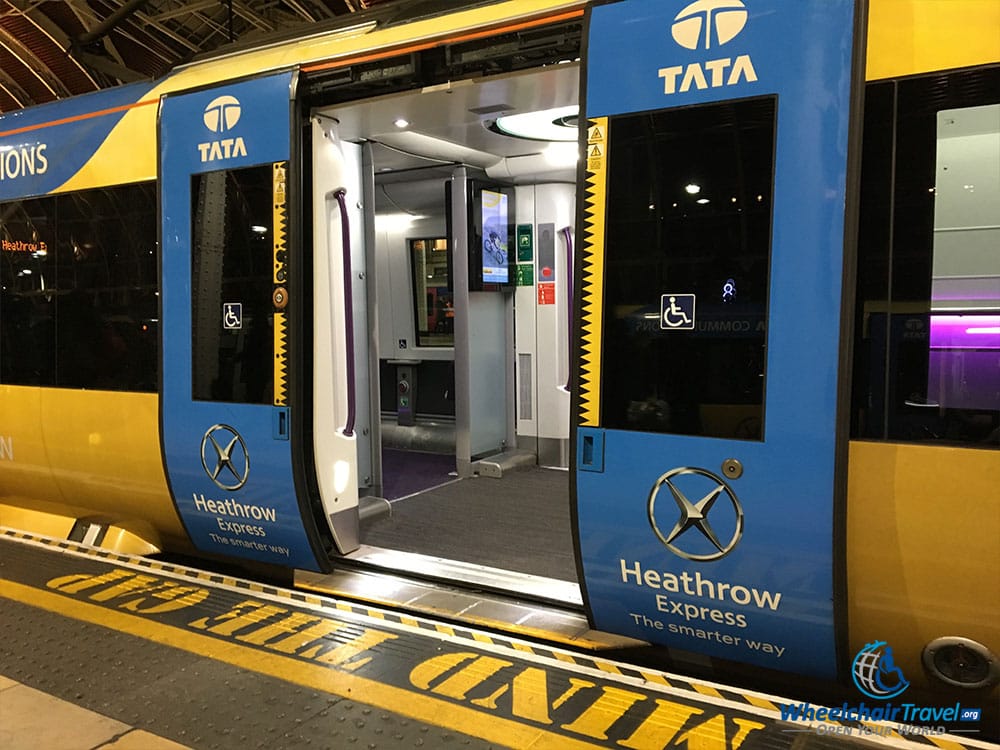
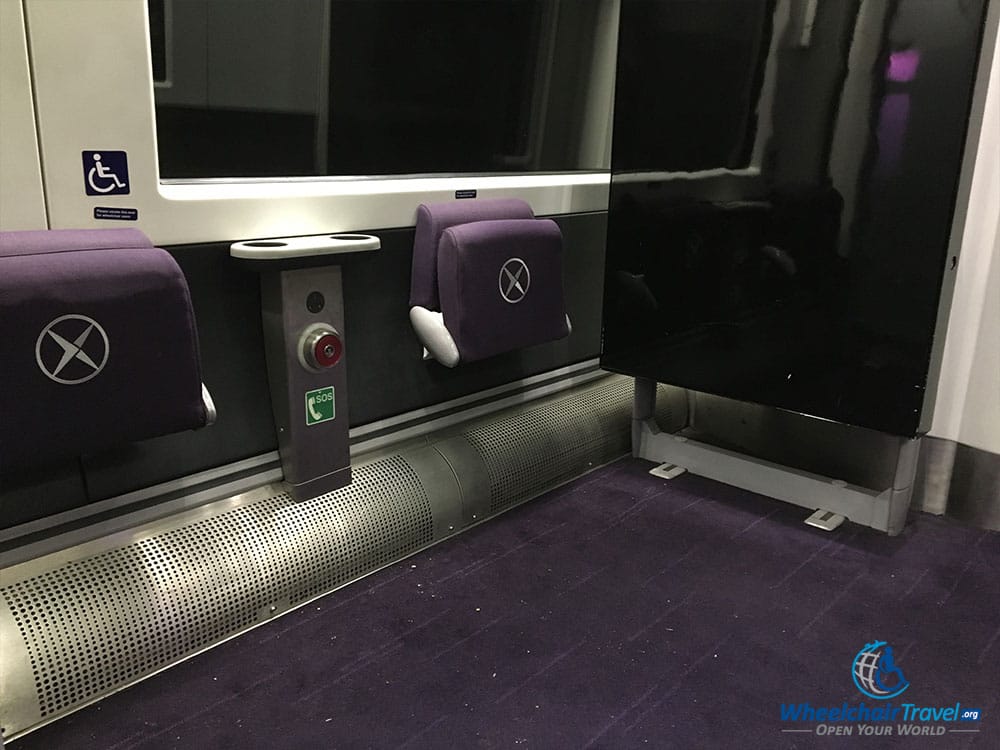
Level-entry boarding is possible at all stations, and the wheelchair spaces onboard offer plenty of room for the largest of power wheelchairs. For more information on riding the Heathrow Express with a wheelchair, read my review by clicking here. I have ridden the Heathrow Express countless times and find the service to be comfortable, affordable, efficient and hassle-free from an accessibility standpoint. Tickets can be purchased in advance at www.heathrowexpress.com or at the station.
Eurostar International Rail
The Eurostar high-speed train connects London to continental Europe, with service to cities that include Brussels, Paris and, beginning in April 2018, Amsterdam. I have written in great detail about the wheelchair accessible Eurostar train from London to Brussels, but I have also taken the service to Paris as well.
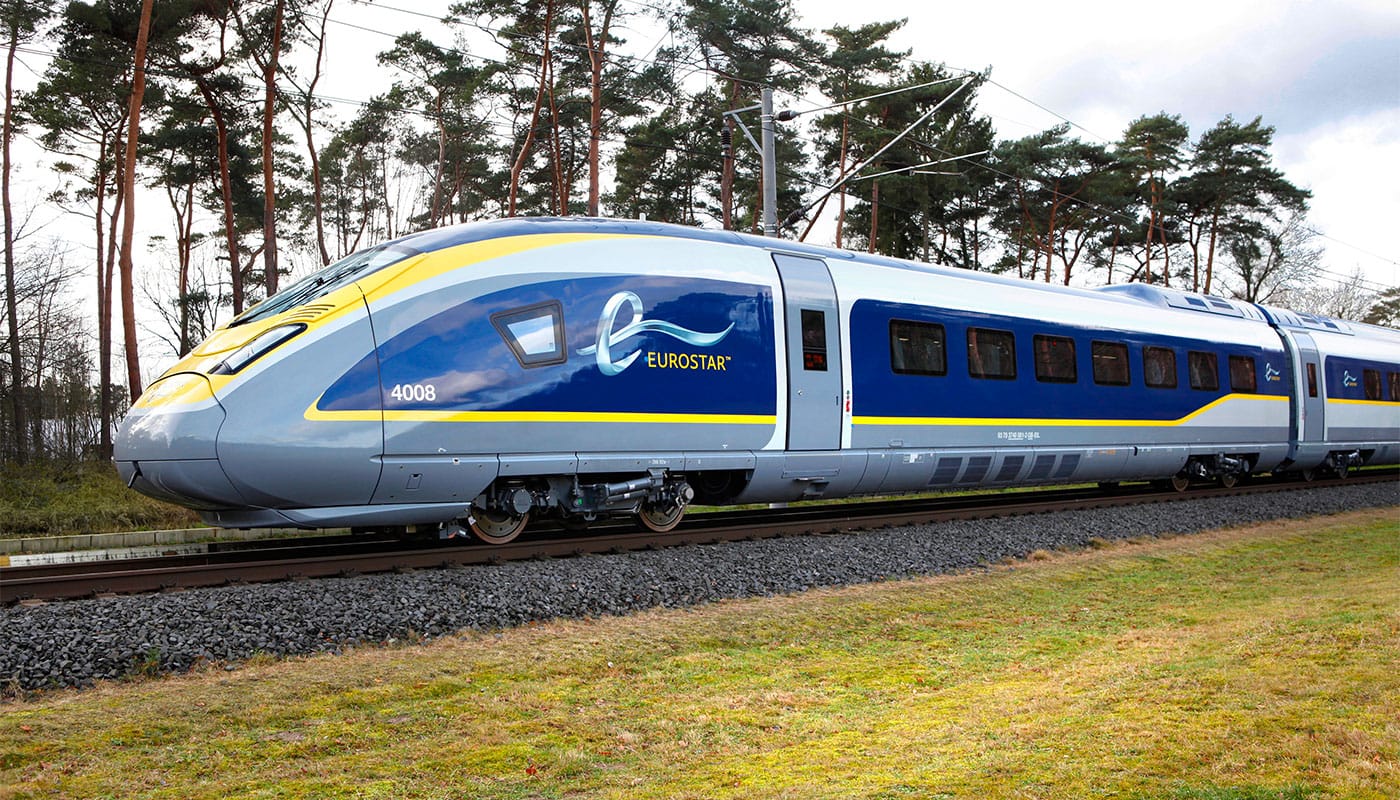
St. Pancras International train station is the home of Eurostar in London, complete with ticketing, check-in, security and passport control. The station are departures hall are both wheelchair accessible. Access to the train platform is via elevator, and boarding is made possible with a ramp.
The trains offer wheelchair accessible spaces onboard, and a substantial discount to travelers with disabilities. For information on how Eurostar tickets are priced, click here. I strongly recommend Eurostar to wheelchair users, as it is fast, convenient and will save you the hassles associated with air travel.



